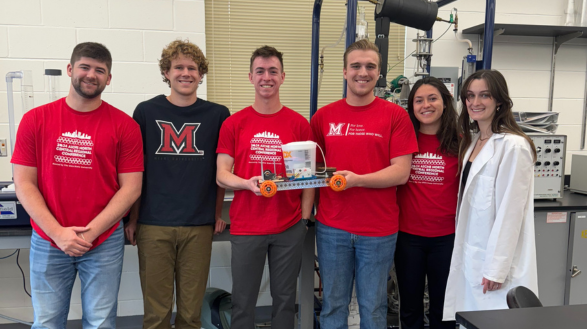Miami engineers race ahead in AIChE ChemE Car Contest
Created for a Senior Design project, this CEC student team's ChemE car has qualified for a national competition in November.

Miami engineers race ahead in AIChE ChemE Car Contest
Six Miami University Chemical Engineering students recently competed in the ChemE car competition at the American Institute of Chemical Engineers (AIChE) North Central Student Regional Conference. The goal of the competition is to create a car that can fit in the size of a shoebox and is powered by some sort of chemical reaction, and the car must travel 18.7m. This year’s team consisted of Austin Brooks, Tim Snider, Nathan Simon, Carmen Riaño Aransay, Jessica Fornshell, and Brice Graham.They placed 6th overall, which meant they qualified for the AIChE National Conference in November.
View this post on Instagram
Miami’s car runs on hydrogen, which generates power to the motor of the car. The team generates the hydrogen themselves to put into a storage container until the car is ready to start. Their design was begun by a team in 2019, but design modifications like moving the gear train and a complete redesign of the containment system were made. Along the way the team ran into some challenges, especially with 3D printing. “Our biggest setback was probably all the issues we had 3D printing, said team member Nathan Simon '24, a chemical engineering major who graduates this upcoming Saturday. "We had a lot more failed prints than we had successful prints. So just getting together, rallying, coming back here all hours of the day just to get those prints done — it's really the biggest rallying point for our team.”
Once the car was complete, the team was ready to compete at theAIChE North Central Student Regional Conference competition which took place April 2-6 at OSU. This was only the second time Miami has had a team compete. The team performed very well, with their first run coming in 4.83 m from the goal (cars are judged by distance, not speed.) This performance earned Miami's ChemE car team a spot to compete in the national conference in November alongside other top performers Trine University, University of Toledo, University of Michigan, and Cleveland State University.
According to the team, the competition was a great way for students to showcase their knowledge of chemical engineering while also networking and meeting new people, whether they were competing or not. The competition had some downtime for some team bonding and getting to hear insights from other teams. “We were able to talk to other teams and meet people and see ideas they have for the cars, said team member Carmen Riaño Aransay '24, an international biomedical engineering major from Spain who is also a champion on Miami University's Track and Field team. "There were so many people that came that weren't competing, who were there to cheer on the competition,” said Carmen, who graduates cum laude with a Bachelor of Science in Biomedical Engineering on Saturday.
Participating and creating the car taught the team new skills relating to chemical engineering and how to work as a team. “I think it's definitely taught me a lot about hydrogen fuel cells," said Jessica Fornshell '24, a chemical engineering major who will also graduate on Saturday. "You learn a lot of concepts throughout your time in different classes," explained Jessica, who went on to say that "really putting it into practice" has been particularly impactful for her learning. "Combining the different aspects of engineering and having hands-on experience has really given me a deeper understanding of chemical engineering,” Jessica said.
Since five out of six of the team members will be graduated and on to new jobs or in pursuit of advanced degrees after this weekend, an almost entirely new team will be competing for the AIChE National Conference in November using the car this team built. Because of that, the current team has some advice for them. “Start early," is Austin Brooks' advice. "I feel like the earlier you start on the car and the improvements and modifications, the less work you have towards the end." Austin went on to say that, "At the end, since you have more time, you're going to add little finer tweaks that will maybe give you an extra foot off the line."
We can't wait to see how the CEC ChemE car performs in November!